|
 Index Index
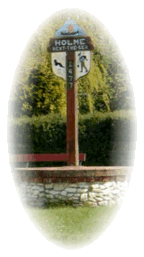 Holme-next-the-Sea is a
village and parish situated between Hunstanton and Thornham on the coast road from Wells to Lynn .... in the North Western
division of the county, Smithdon hundred, Smithdon and Brother cross petty
sessional division ... etc, etc. This is the beginning of the description
of our village as it appears in Directories and guide books. We decided
that we might improve upon this, by describing a walk round Holme. So on
Monday, 11th June, 1951, we set out, with Peggy Jewell, Carolyn Palmer and
Brenda Flatt carrying pencils and paper, to act as "scribes"
during the walk. After leaving the school we pass the Church-yard, where
Mr. Tom Rason is busy with a scythe. Mervyn Proudfoot, his great nephew,
stops to explain to him what we are doing.
Holme-next-the-Sea is a
village and parish situated between Hunstanton and Thornham on the coast road from Wells to Lynn .... in the North Western
division of the county, Smithdon hundred, Smithdon and Brother cross petty
sessional division ... etc, etc. This is the beginning of the description
of our village as it appears in Directories and guide books. We decided
that we might improve upon this, by describing a walk round Holme. So on
Monday, 11th June, 1951, we set out, with Peggy Jewell, Carolyn Palmer and
Brenda Flatt carrying pencils and paper, to act as "scribes"
during the walk. After leaving the school we pass the Church-yard, where
Mr. Tom Rason is busy with a scythe. Mervyn Proudfoot, his great nephew,
stops to explain to him what we are doing.
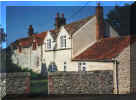 We
move on past Church Row and Kirk Gate, where the house and garden have
been considerably altered and improved during the past year and Mr.
Sheldrake's garden with its many bee‑hives. Mr. Sheldrake is well‑known
in North‑west Norfolk, not only as a member of Docking Rural
District Council, but also on account of his honey. We
move on past Church Row and Kirk Gate, where the house and garden have
been considerably altered and improved during the past year and Mr.
Sheldrake's garden with its many bee‑hives. Mr. Sheldrake is well‑known
in North‑west Norfolk, not only as a member of Docking Rural
District Council, but also on account of his honey.
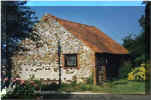 On
the corner we see what was once the Blacksmith's shop, and before that the
village pound, where stray animals and poultry were placed in the old
days. Turning up Eastgate, we find the garden of Mr. Craske
(market-gardener) a mass of colour, and at Eastgate Cottage, opposite, the
old mangers, now filled with flowers, look most attractive. On
the corner we see what was once the Blacksmith's shop, and before that the
village pound, where stray animals and poultry were placed in the old
days. Turning up Eastgate, we find the garden of Mr. Craske
(market-gardener) a mass of colour, and at Eastgate Cottage, opposite, the
old mangers, now filled with flowers, look most attractive.
 Smuggler's
Cottage lacks mystery in today's bright sunlight; it is hard to imagine it
as it was a century ago. Outside Mr.W.Renaut's dairy we pause to discuss
how long the Gascoigne milking machine has been in use; we decide it was
introduced two years ago. Where Eastgate joins the main coast road there
is a maze of telegraph and electricity wires overhead. The post-box nearby
is cleared twice daily. We have not time today to travel towards the
"East End" of Holme, where the most notable features are the
large mushroom and fruit farm owned by Major Whittaker, and the number of
comparatively new houses and bungalows on the North side of the coast
road. So we turn right along the main road. All is quiet in Mr. Renaut's
yard on the corner; Boxer and Bouncer, two of
his horses, are grazing on the far side of the gate. On the left is
Holme Manor. Eileen Batterbee and Carolyn Palmer decide to call on Mrs.
Simms‑Reeve to ask for a few facts about the history of the house.
Our Manor, we are told, was built early in the 16th century, but
unfortunately the front part was pulled down and rebuilt in 1854. It has
been in the possession of the Blyth family for over a hundred years. In
the Manor grounds is Holme Bowling Green. The Bowls Club was formed in
1949. Holme Cricket is much older and has had numerous successes in the
past years. The Cricket field is on the East side of Chalkpit Lane.
Details of these and other Holme Clubs will be found elsewhere in this
book. As we pass Old Farm Cottages, Colin Matthews, who lives there,
informs us that a stone in the wall of his house bears the date 1535, and
that there are stones from the old church in the walls. There is an old
sundial in the south wall of these cottages, similar to that over the
Church porch. Nearly opposite, by way of contrast, is the bungalow built a
few years ago by Mr. Richardson. Barnwell Cottages, on the North side of
the main road, were built in 1936, and these, with the Council houses of
"Mainway" erected in 1927, form the main blocks of the new part
of Holme which has arisen during the past half-century. There is also
Aslack Way, named after the Aslack family, land-owners in Holme from the
16th century onwards. We pass the old mile-stone (18 miles to Lynn) and
the bus-stop opposite to Mrs. Hill's shop. Buses-run regularly to
Hunstanton and Wells, and from Hunstanton there are frequent buses to
Lynn. The fare to Hunstanton is 4d, and from there to Lynn, 1/9 (2/3
return, children half price). Further on, at the Ringstead Crossroads,
where the Peddar's Way crosses the Coast road, people are waiting for the
bus from Docking to Hunstanton. We pass the bungalow named
"Ismailia" which is for sale, and see Mr. Charlie Potter working
his allotment. A fine American car rolls past as we turn right at the
crossroads, and walk northwards down the last stretch of that mysterious
old road, the Peddars Way. On our right is the neat vegetable plot of Mr.
Wilkins, Market Gardener. Then we pass the Vicarage, empty since the Rev.
Harper left Holme last year, and Mr. John Renaut's house standing well
back from the road. Until a few years ago the first motor‑car seen
in Holme (owned by Mr. Thomas Nelson) was kept in a Shed at the back of
the vicarage. Now, there are about 30 cars and 15 motor cycles and a cycle
with a mini‑motor attached has made its appearance in the last few
weeks. The field at the back of the Post Office has been changed
considerably during the past year; the trees have been removed, and a pond
filled in. Smuggler's
Cottage lacks mystery in today's bright sunlight; it is hard to imagine it
as it was a century ago. Outside Mr.W.Renaut's dairy we pause to discuss
how long the Gascoigne milking machine has been in use; we decide it was
introduced two years ago. Where Eastgate joins the main coast road there
is a maze of telegraph and electricity wires overhead. The post-box nearby
is cleared twice daily. We have not time today to travel towards the
"East End" of Holme, where the most notable features are the
large mushroom and fruit farm owned by Major Whittaker, and the number of
comparatively new houses and bungalows on the North side of the coast
road. So we turn right along the main road. All is quiet in Mr. Renaut's
yard on the corner; Boxer and Bouncer, two of
his horses, are grazing on the far side of the gate. On the left is
Holme Manor. Eileen Batterbee and Carolyn Palmer decide to call on Mrs.
Simms‑Reeve to ask for a few facts about the history of the house.
Our Manor, we are told, was built early in the 16th century, but
unfortunately the front part was pulled down and rebuilt in 1854. It has
been in the possession of the Blyth family for over a hundred years. In
the Manor grounds is Holme Bowling Green. The Bowls Club was formed in
1949. Holme Cricket is much older and has had numerous successes in the
past years. The Cricket field is on the East side of Chalkpit Lane.
Details of these and other Holme Clubs will be found elsewhere in this
book. As we pass Old Farm Cottages, Colin Matthews, who lives there,
informs us that a stone in the wall of his house bears the date 1535, and
that there are stones from the old church in the walls. There is an old
sundial in the south wall of these cottages, similar to that over the
Church porch. Nearly opposite, by way of contrast, is the bungalow built a
few years ago by Mr. Richardson. Barnwell Cottages, on the North side of
the main road, were built in 1936, and these, with the Council houses of
"Mainway" erected in 1927, form the main blocks of the new part
of Holme which has arisen during the past half-century. There is also
Aslack Way, named after the Aslack family, land-owners in Holme from the
16th century onwards. We pass the old mile-stone (18 miles to Lynn) and
the bus-stop opposite to Mrs. Hill's shop. Buses-run regularly to
Hunstanton and Wells, and from Hunstanton there are frequent buses to
Lynn. The fare to Hunstanton is 4d, and from there to Lynn, 1/9 (2/3
return, children half price). Further on, at the Ringstead Crossroads,
where the Peddar's Way crosses the Coast road, people are waiting for the
bus from Docking to Hunstanton. We pass the bungalow named
"Ismailia" which is for sale, and see Mr. Charlie Potter working
his allotment. A fine American car rolls past as we turn right at the
crossroads, and walk northwards down the last stretch of that mysterious
old road, the Peddars Way. On our right is the neat vegetable plot of Mr.
Wilkins, Market Gardener. Then we pass the Vicarage, empty since the Rev.
Harper left Holme last year, and Mr. John Renaut's house standing well
back from the road. Until a few years ago the first motor‑car seen
in Holme (owned by Mr. Thomas Nelson) was kept in a Shed at the back of
the vicarage. Now, there are about 30 cars and 15 motor cycles and a cycle
with a mini‑motor attached has made its appearance in the last few
weeks. The field at the back of the Post Office has been changed
considerably during the past year; the trees have been removed, and a pond
filled in.
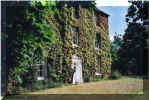 Over
to our left we can see Holme House, formerly occupied by Mr. Matthew
Nelson, and now by Mrs.S.C. Reed, it was partly destroyed by fire early in
1947, during the coldest spell of weather during recent years. Beyond
Holme House are the widely known Riding Stables, where Miss Nancy Wheeler
keeps over 60 horses. There are a number of new houses down Beach Road,
and on the left near the river is the Riverside Camping Ground where about
30 caravans are to be seen at the moment. Over
to our left we can see Holme House, formerly occupied by Mr. Matthew
Nelson, and now by Mrs.S.C. Reed, it was partly destroyed by fire early in
1947, during the coldest spell of weather during recent years. Beyond
Holme House are the widely known Riding Stables, where Miss Nancy Wheeler
keeps over 60 horses. There are a number of new houses down Beach Road,
and on the left near the river is the Riverside Camping Ground where about
30 caravans are to be seen at the moment.
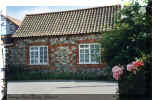 However
we have not time to make a complete tour of the village today, so we turn back
towards the school leaving behind us the Post Office and shop, where Mr.
Palmer is in charge; his taxi is parked nearby. Opposite is the Chapel built
in 1875, where children's and evening services are held every Sunday. We pass
the bus time table and parish notice board then Mrs. Burton's new shop, on the
right, and the "White Horse on the left. At the back of the latter is the
White Horse Camping Ground, in which several caravans can be seen from the
road. Beyond Rose Cottage on the right we see the two newest houses in Holme
(completed in 1950) before reaching the institute on the opposite side. Our
walk actually ends at the school, a few yards further on, but for the purposes
of this account we will stop at the institute, for this building, erected in
1914, is the centre of most of the social activities of the village. During
the winter months the Men's "Night School" as it is still called,
meets here regularly. Mrs.C Burton is the President of this club, of which the
members compete every year for an 'indoor games' Cup, at present held by Mr.
Gilbert Walker. The Mother's Union meets in the Institute, too. In spite of
the fact that Holme has been without a Vicar for the past year, the small
committee has arranged some very good meetings, and on the 13th June a party
visited London to see the Houses of Parliament and Mary Summer House.
The Institute is also the centre for Holme Young People's Club. This
Club formed in 1948, has forty members, aged 12 to 21, from Holme and the
surrounding parishes; and has been represented at practically all the
"Youth Functions" in West Norfolk during the past two years. At the
West Norfolk Youth Sports at Gaywood on the 16th June this year, the Club won
the "Under Sixteen" Cup, and was placed third in the contest for the
Lynn News shield for which twelve clubs competed.
This Institute is equipped with a radio-gram and "Pam"
amplifying equipment, purchased in 1946 with the proceeds of a number of
social functions. Dances
and Socials are held frequently during the winter months, and are usually well
attended. Old Tyme Dancing became very popular a few years ago, but there has
been a movement towards a return to Modern Dancing during the past 12 months,
encouraged by a series of lessons in Modern and Old Tyme Dancing by Miss
Pamela Witley of Hunstanton, during the winter of 1950/51. A number of young
people go regularly to dances in Hunstanton, but the Cinema is the chief
attraction there, with a change of film every Monday, Tuesday and Sunday. Cost
of admission is l0d., 1/6, 1/10, 2/10, and 3/6 (children half-price).
The Hunstanton Golf Course extends to the Beach Road at Holme, and it
is understandable that there is considerably interest in this sport in the
village. Various competitions are held every year, and 1951 has been
particularly important, for the Amateur Golf Championship was held at
Hunstanton in spring. The Chart in the following pages shows that most of the
workers of Holme are employed in farm‑work. A number of crops are grown,
and details of the rotation of these are also given. There is also a
considerable amount of market gardening, much of the produce being sold in
Hunstanton. The chief topic of conversation in our village or elsewhere at the
time of writing is the rise in the cost of living during the years since the
war. Details of prices of food, are given in the following pages, but by the
time this book is read there are almost certain to have been further changes However
we have not time to make a complete tour of the village today, so we turn back
towards the school leaving behind us the Post Office and shop, where Mr.
Palmer is in charge; his taxi is parked nearby. Opposite is the Chapel built
in 1875, where children's and evening services are held every Sunday. We pass
the bus time table and parish notice board then Mrs. Burton's new shop, on the
right, and the "White Horse on the left. At the back of the latter is the
White Horse Camping Ground, in which several caravans can be seen from the
road. Beyond Rose Cottage on the right we see the two newest houses in Holme
(completed in 1950) before reaching the institute on the opposite side. Our
walk actually ends at the school, a few yards further on, but for the purposes
of this account we will stop at the institute, for this building, erected in
1914, is the centre of most of the social activities of the village. During
the winter months the Men's "Night School" as it is still called,
meets here regularly. Mrs.C Burton is the President of this club, of which the
members compete every year for an 'indoor games' Cup, at present held by Mr.
Gilbert Walker. The Mother's Union meets in the Institute, too. In spite of
the fact that Holme has been without a Vicar for the past year, the small
committee has arranged some very good meetings, and on the 13th June a party
visited London to see the Houses of Parliament and Mary Summer House.
The Institute is also the centre for Holme Young People's Club. This
Club formed in 1948, has forty members, aged 12 to 21, from Holme and the
surrounding parishes; and has been represented at practically all the
"Youth Functions" in West Norfolk during the past two years. At the
West Norfolk Youth Sports at Gaywood on the 16th June this year, the Club won
the "Under Sixteen" Cup, and was placed third in the contest for the
Lynn News shield for which twelve clubs competed.
This Institute is equipped with a radio-gram and "Pam"
amplifying equipment, purchased in 1946 with the proceeds of a number of
social functions. Dances
and Socials are held frequently during the winter months, and are usually well
attended. Old Tyme Dancing became very popular a few years ago, but there has
been a movement towards a return to Modern Dancing during the past 12 months,
encouraged by a series of lessons in Modern and Old Tyme Dancing by Miss
Pamela Witley of Hunstanton, during the winter of 1950/51. A number of young
people go regularly to dances in Hunstanton, but the Cinema is the chief
attraction there, with a change of film every Monday, Tuesday and Sunday. Cost
of admission is l0d., 1/6, 1/10, 2/10, and 3/6 (children half-price).
The Hunstanton Golf Course extends to the Beach Road at Holme, and it
is understandable that there is considerably interest in this sport in the
village. Various competitions are held every year, and 1951 has been
particularly important, for the Amateur Golf Championship was held at
Hunstanton in spring. The Chart in the following pages shows that most of the
workers of Holme are employed in farm‑work. A number of crops are grown,
and details of the rotation of these are also given. There is also a
considerable amount of market gardening, much of the produce being sold in
Hunstanton. The chief topic of conversation in our village or elsewhere at the
time of writing is the rise in the cost of living during the years since the
war. Details of prices of food, are given in the following pages, but by the
time this book is read there are almost certain to have been further changes
Top of Page
|